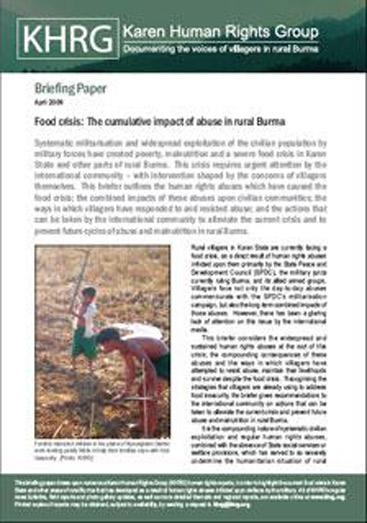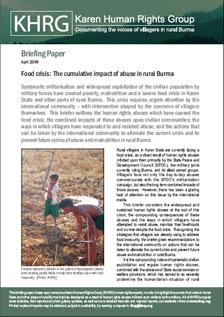Systematic militarisation and widespread exploitation of the civilian population by military forces have created poverty, malnutrition and a severe food crisis in Karen State and other parts of rural Burma. This crisis requires urgent attention by the international community - with intervention shaped by the concerns of villagers themselves. This briefer outlines the human rights abuses which have caused the food crisis; the combined impacts of these abuses upon civilian communities; the ways in which villagers have responded to and resisted abuse; and the actions that can be taken by the international community to alleviate the current crisis and to prevent future cycles of abuse and malnutrition in rural Burma.
Introduction and Executive Summary
This briefer considers the widespread and sustained human rights abuses at the root of this crisis, the compounding consequences of these abuses and the ways in which villagers have attempted to resist abuse, maintain their livelihoods and survive despite the food crisis. Recognising the strategies that villagers are already using to address food insecurity, the briefer gives recommendations to the international community on actions that can be taken to alleviate the current crisis and prevent future abuse and malnutrition in rural Burma. Rural villagers in Karen State are currently facing a food crisis, as a direct result of human rights abuses inflicted upon them primarily by the State Peace and Development Council (SPDC), the military junta currently ruling Burma, and its allied armed groups. Villagers face not only the day-to-day abuses commensurate with the SPDC's militarisation campaign, but also the long-term combined impacts of those abuses. However, there has been a glaring lack of attention on this issue by the international media.
It is the compounding nature of systematic civilian exploitation and regular human rights abuses, combined with the absence of State social services or welfare provisions, which has served to so severely undermine the humanitarian situation of rural communities in Karen State. In areas under SPDC control, villagers' traditional livelihood activities and means of producing and purchasing food are being increasingly eroded over time under the combined burden of military demands for labour, food, money, land and other resources:
-
Regular forced labour cuts into time needed for agriculture or other work;
-
Extortion and looting of food and livestock by patrolling military units undermines villagers' own nutrition and household needs;
-
Paddy and other crop quotas force villagers to hand over significant portions of their crop yields to procurement officers, meaning a loss of potential revenue as well as directly reducing community food supplies;
-
Arbitrary taxation and demands for money deplete villagers' limited savings, weakening their ability to purchase food from neighbouring towns;
-
Land confiscation for so-called 'development' projects, such as the building of roads and dams, leaves villagers with decreased land on which to grow their crops;
-
Forced agricultural projects require that villagers replace traditional food crops with non-edible crops, such as castor bean (used to create bio-fuel) or rubber;
-
Forced relocation places villagers in fenced compounds, in barren plain lands, with small plots of land which are insufficient for meeting a family's food provision needs;
-
Finally, restrictions on movement, employed to more efficiently control the population, limit opportunities for trade and work outside of village confines and prevent villagers from evading the demands imposed upon them.
Any one of the above military demands taken alone undermines the ability of civilian communities to address nutritional needs. However, when experienced in combination over a sustained period of time, villagers' options for managing even their basic subsistence needs become highly constrained. In order to meet the combined financial requirements of military demands and household subsistence, and with limited local employment options in a cash economy, villagers are frequently pushed towards selling off personal possessions and/or incurring debt. The consequent increase in rural poverty (in terms of diminished fiscal liquidity; loss of personal possessions and food supplies; and loss of access to a means of production, as agricultural land is sold off to pay, or avoid taking on, debts) has created a pervasive food crisis in rural SPDC-controlled Karen State.
"Only two villagers out of ten have enough rice. They're borrowing from each other just to stay alive. During the dry season, they go to other villages to look for work and try to save food for the rainy season. Most of the villagers are doing this. [But] from the time we finish with the [seasonal] farm work, we're ordered to repair four furlongs [approx. 800 meters] of the Lay Gkay car road... Some villagers have become weaker because they've had to do a lot of forced labour."
- Saw P--- (male, 68), S--- village, Thaton District (May 2008)
In areas outside of SPDC control, the SPDC employs a variety of measures to prevent the distribution of crucial food supplies to hiding villagers in order to undermine civilian efforts to evade military control. Well aware of the abuses and livelihood restrictions they will face under military control (as described above), villagers actively avoid SPDC attempts to force them into relocation sites or military-controlled villages and instead flee into the forested mountains in advance of approaching military units.
Although villagers generally prioritise food supplies and cooking equipment when they flee into hiding, they are limited as to the amount they are able to carry and, therefore, must return home to collect further supplies or access alternative food sources within several weeks of displacement. However, as villagers flee, soldiers regularly fire mortar rockets into villages and then enter the villages in order to torch homes, food storage barns and fields, kill livestock and destroy agricultural and cooking equipment - often leaving villagers with little left to salvage. Even so, soldiers also plant landmines around villagers' homes, community buildings and fields in order to prevent villagers from returning. Furthermore, hiding villagers are deemed 'enemies of the state' and soldiers are issued a 'shoot-on-sight' policy for any civilians encountered in areas outside of consolidated military control, making it even more dangerous for villagers to leave their hiding sites and return to harvest remaining crops or collect hidden food supplies.
Even though many villagers remain close to their home areas and often return after the troops have departed, this pattern of attack and displacement disrupts traditional planting and harvesting cycles, leading to failed or much reduced harvests. Moreover, crops left behind during displacement are often overtaken by weeds or destroyed by wild animals and insects, while livestock - particularly buffalos used to plough and harvest fields - are killed when they trigger landmines laid by SPDC soldiers.
In addition to the destruction of abandoned food supplies and agricultural fields and the measures employed to prevent villagers from being able to return, movement restrictions upon those under SPDC control effectively prevent hiding villagers from being able to access food supplies elsewhere. Fences around villages, strict rules on villager movement, road blocks and the SPDC's shoot-on-sight policy all work to prevent trade between controlled and non-controlled communities. Together, these measures diminish flows of crucial food supplies into non-SPDC-controlled areas - a result intended by a military force that hopes to starve villagers out of the hills and into SPDC-controlled areas in the plains.
Poverty, malnutrition and the dire food crisis in the region are the direct consequence of systematic military predation in rural Karen State - a pattern which is repeated across much of rural Burma. [1] Reduced harvests resulting from excessive military demands, the extortion and destruction of food stocks, and restrictions upon the movement of food, amongst other abuses, leave villagers with insufficient food supplies and a lack of diversity in their diets. The global economic crisis, climate change and rising world food prices only add to the difficulties villagers are already facing in providing enough food for their families. The consequent malnutrition of a large portion of the rural population has far-reaching social, economic and political implications both within and beyond Burma's borders. Malnutrition makes villagers more susceptible to illness and disease. At the same time, living hand-to-mouth leaves communities without the necessary savings to purchase medicines or food stockpiles to fall back upon whilst caring for the sick or injured, creating a deplorable health situation. Meanwhile, families already struggling to meet their nutritional needs are unable to send their children to school and are instead often forced to put their children to work for the family's livelihood or to meet military demands, undermining education and child development. Combined with the food crisis itself, these factors create large-scale internal displacement and refugee and migrant worker flows into neighbouring countries.
However, in highlighting this food crisis, it is important to note that villagers in rural Burma are not just helpless victims. Rather, they are actively resisting abuse and are constantly developing and honing strategies to address their nutritional needs. These strategies are surveyed towards the end of this report. Nevertheless, without external support for these strategies, the food crisis will continue to constrain villagers' abilities to evade SPDC control, resist abuse and address other social and economic needs.
The food crisis in rural Burma has been acknowledged by both the World Food Program and Food and Agricultural Organisation of the United Nations and necessitates urgent action by the international community. [2] Given the efforts of local communities to address food security issues themselves, all such action must be conducted in a manner supportive of the strategies that villagers in rural Burma are already using to resist abuse. Thus, the international community's response to the crisis must be informed and shaped by the concerns of rural villagers themselves. The imperative to act is underpinned by the internationally-recognised right to food. As explained by Jean Ziegler, former UN Special Rapporteur on the Right to Food,
"The right to food means that Governments must not take actions that result in increasing levels of hunger, food insecurity and malnutrition... The right to food is a human right and is a binding obligation well-established under international law, recognised in the Universal Declaration on Human Rights." [3]
Key Recommendations
-
Listen to the voices of villagers and incorporate their concerns and suggestions into ongoing humanitarian programming and policy making in Burma
-
Scale up humanitarian aid to reach those communities currently facing a food crisis, increasing support for cross-border aid and local civil society organisations in those areas not regularly accessible by Rangoon-based agencies
-
Acknowledge the political implications of aid delivery in Burma and refrain from activities which strengthen military control over civilians (such as aid to relocation sites or SPDC-implemented humanitarian or development projects)
-
Conduct human rights impact assessments as an integral part of all humanitarian and development programmes implemented in Burma
-
Support local food security protection measures and efforts to resist the abuses underpinning the crisis
-
Report the current food crisis and include the voices of rural villagers in ongoing international journalism and advocacy efforts
The full report is only available in PDF format.
Footnotes:
[1]For information on the food crisis in western Burma, see Chin Human Rights Group, July 2008, Critical Point: Food Scarcity and Hunger in Burma's Chin State; and Human Rights Watch, January 2009, "We Are Like Forgotten People" The Chin People of Burma: Unsafe in Burma, Unprotected in India.
[2] The Irrawaddy, UN: Burma Faces Food Crisis, January 28th 2009.
UNOCHA - IRIN, Myanmar: Rohingya face rising food insecurity, April 1st 2009.
[3] Right to Food, What is the right to food?, accessed on April 2nd 2009.





